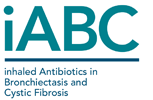Scientific Outputs
Below are some highlighted scientific outputs. Further work resulting from the iABC project can be found in our Library section.
Whole Genome Sequencing of chronic lung pathogens in CF and BE.
Work was undertaken in WP7 of the project to characterize the genetic diversity, virulence factors and antimicrobial resistance mechanisms of, with a focus on GNnF. To this end, a strain bank of 1000 isolates was collected, principally in Spain, The Netherlands and the UK. The collection included 500 P. aeruginosa isolates and 500 other Gram-negative rods, namely: Stenotrophomonas, Achromobacter, Burkholderia, Haemophilus, Pandoraea and Ralstonia species, and Enterobacterales. The isolates were fully typed by WGS. Reference schemes were developed in SeqSphere. Genetic analysis was performed separately per bacterial genus. Species classification was confirmed or corrected, or in some cases putative new species were proposed. Genetic diversity and clonality were analyzed, as were the main resistance mechanisms, which were correlated to susceptibility data that were previously generated within iABC.
Work on a part of the collection, in particular on P. aeruginosa and Burkholderia species will continue after finalization of the funding period and closure of the iABC project. In general, a high genetic diversity of chronic lung pathogens was found in CF and BE, which suggests an important role for acquisition from the environment, despite multiple reports of major outbreaks within the CF community. Genetic analyses, including heat maps, suggest also a higher taxonomical diversity than previously thought. The genera Stenotrophomonas, Pandoraea, Ralstonia and Achromobacter likely need taxonomic re-evaluation with addition of novel species; some of these putative novel species have been described for time in this work. Much has been learned from this analysis. Resistance genes have been mapped and analyzed, often showing hight diversity in mechanisms and sometimes pointing to mechanisms not (yet) linked to specific resistance genes. A number of virulence factors seem to be overly, or universally, present in isolates from certain species, but much remains to be elucidated about their contribution to chronic pulmonary infection and their interplay with the host in this process. Only a combination of carefully collected genetic data, susceptibility data and clinical data will be able to provide such.
Contact: Dr Miquel Ekkelenkamp m.ekkelenkamp@umcutrecht.nl
Development of the βENaC mouse model
Pseudomonas aeruginosa (P. aeruginosa) is an opportunistic pathogen and the leading cause of infection in patients with cystic fibrosis (CF). The ability of P. aeruginosa to evade host responses and develop into chronic infection causes significant morbidity and mortality. Several mouse models have been developed to study chronic respiratory infections induced by P. aeruginosa, with the bead agar model being the most widely used. However, this model has several limitations, including the requirement for surgical procedures and high mortality rates. In the paper Pathogens | Free Full-Text | Biologically Relevant Murine Models of Chronic Pseudomonas aeruginosa Respiratory Infection (mdpi.com), we describe novel and adapted biologically relevant models of chronic lung infection caused by P. aeruginosa. Three methods are described: a clinical isolate infection model, utilising isolates obtained from patients with CF; an incomplete antibiotic clearance model, leading to bacterial bounce-back; and the establishment of chronic infection; and an adapted water bottle chronic infection model. These models circumvent the requirement for a surgical procedure and, importantly, can be induced with clinical isolates of P. aeruginosa and in wild-type mice. We also demonstrate successful induction of chronic infection in the transgenic βENaC murine model of CF. We envisage that the models described will facilitate the investigations of host and microbial factors, and the efficacy of novel antimicrobials, during chronic P. aeruginosa respiratory infections.
Contact: Dr Beckie Ingram b.ingram@qub.ac.uk
Anti-biofilm activity of murepavadin against cystic fibrosis Pseudomonas aeruginosa isolates
Objectives: To determine the activity of murepavadin in comparison with tobramycin, colistin and aztreonam, against cystic fibrosis (CF) Pseudomonas aeruginosa isolates growing in biofilms. The biofilm-epidemiological cut-off (ECOFF) values that include intrinsic resistance mechanisms present in biofilms were estimated.
Methods: Fifty-three CF P. aeruginosa isolates from respiratory samples were tested using the Calgary (closed system) device, while 4 [2 clinical (one smooth, one mucoid) and 2 reference strains] were tested using the BioFlux, a microfluidic open model of biofilm testing. Biofilm was stained with SYTO9VR and propidium iodide. The minimal biofilm inhibitory concentration (MBIC) and the minimal biofilm eradication concentration (MBEC) were determined. The MBIC-ECOFF and the MBEC-ECOFF were calculated.
Results: Colistin, tobramycin and murepavadin presented similar MBIC50/MBIC90 values (4/32, 8/64 and 2/32, respectively). Murepavadin exhibited the lowest MBEC90 (64 mg/L). Aztreonam MBIC and MBEC values were higher than those of the other antibiotics tested. Tobramycin and murepavadin had the lowest MBEC-ECOFF (64 and 128 mg/L, respectively), while those of aztreonam and colistin exceeded 512 mg/L. Using the BioFlux, for the PAO1, PAO mutS and the smooth clinical strain, a significant difference (P < 0.0125) was observed when comparing the fluorescence of treated and untreated biofilms. For the mucoid strain, only the biofilm treated with aztreonam (MBIC and MBEC) and tobramycin (MBEC) showed differences with respect to the untreated biofilm.
Conclusions: Murepavadin demonstrated good activity against P. aeruginosa biofilms both in open and closed systems. The MBIC-ECOFF and the MBEC-ECOFF are proposed as new parameters to estimate the activity of anti[1]biotics on biofilms
Contact: Dr Marıa Dıez-Aguilar maria_diez_aguilar@hotmail.com
Use of Calgary and Microfluidic BioFlux Systems To Test the Activity of Fosfomycin and Tobramycin Alone and in Combination against Cystic Fibrosis Pseudomonas aeruginosa Biofilms
Pseudomonas aeruginosa is a major cause of morbidity and mortality in chronically infected cystic fibrosis patients. Novel in vitro biofilm models which reliably predict the therapeutic success of antimicrobial therapies against biofilm bacteria should be implemented. The activity of fosfomycin, tobramycin, and the fosfomycin-tobramycin combination against 6 susceptible P. aeruginosa strains iso[1]lated from respiratory samples from cystic fibrosis patients was tested by using two in vitro biofilm models: a closed system (Calgary device) and an open model based on microfluidics (BioFlux). All but one of the isolates formed biofilms. The fosfomycin and tobramycin minimal biofilm inhibitory concentrations (MBIC) were 1,024 to [1]1,024 [1]g/ml and 8 to 32 [1]g/ml, respectively. According to fractional inhibitory concentration analysis, the combination behaved synergistically against all the iso[1]lates except the P. aeruginosa ATCC 27853 strain. The dynamic formation of the bio[1]film was also studied with the BioFlux system, and the MIC and MBIC of each antibi[1]otic were tested. For the combination, the lowest tobramycin concentration that was synergistic with fosfomycin was used. The captured images were analyzed by mea[1]suring the intensity of the colored pixels, which was proportional to the biofilm bio[1]mass. A statistically significant difference was found when the intensity of the inocu[1]lum was compared with the intensity of the microchannel in which the MBIC of tobramycin, fosfomycin, or their combination was used (P0.01) but not when the MIC was applied (P [1] 0.01). Fosfomycin-tobramycin was demonstrated to be syner[1]gistic against cystic fibrosis P. aeruginosa strains in the biofilm models when both the Calgary and the microfluidic BioFlux systems were tested. These results support the clinical use of this combination.




